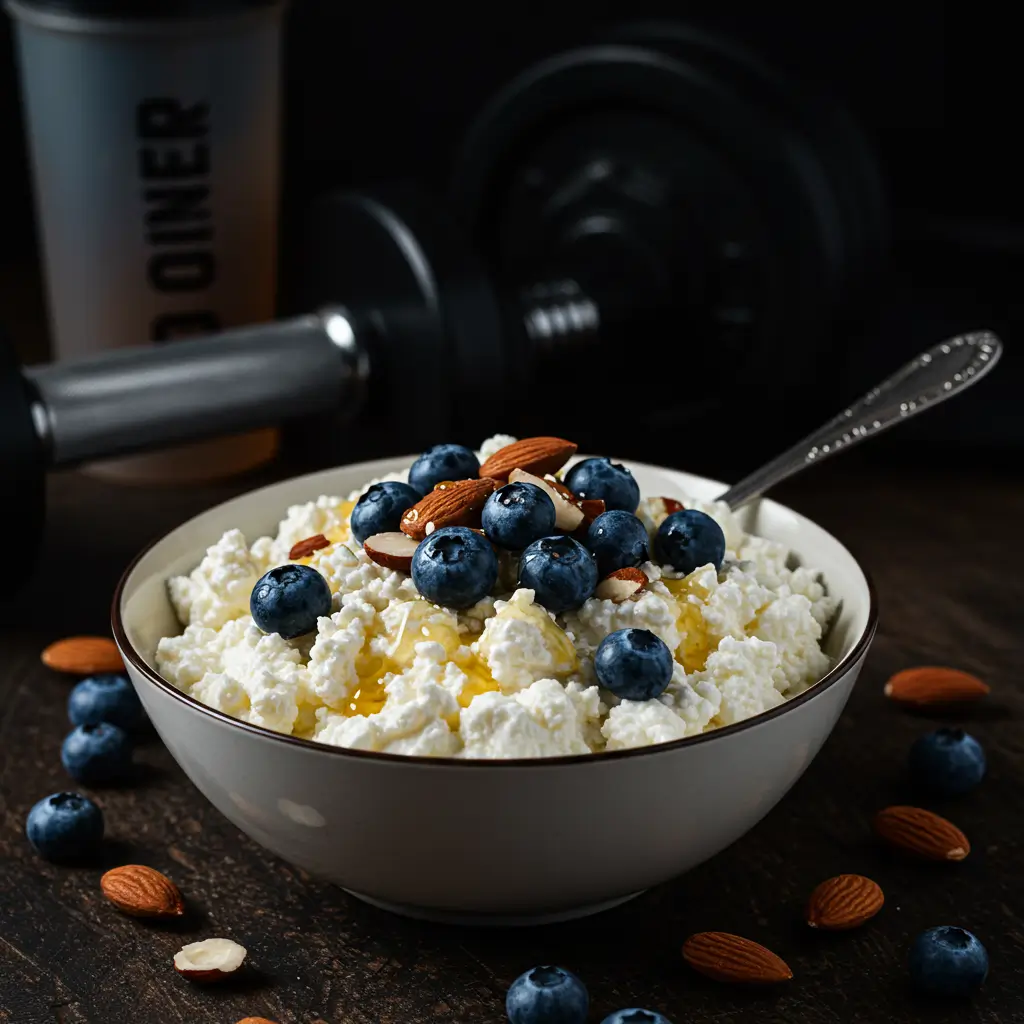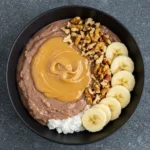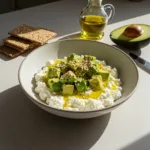
Cottage cheese muscle building look, it’s not sexy. It’s the lumpy, unassuming stuff in the back of the dairy aisle that your grandma probably ate. I remember my first coach, this old-school guy with forearms like telephone poles, telling me it was a non-negotiable part of the plan. The texture? Kinda weird. The taste? Well, it’s a canvas. But the results… oh man, the results are undeniable. This article is your deep dive into why this humble food is a secret weapon. We’re going beyond the basics, into the science, the strategies, and the recipes that turn this stuff into pure muscle fuel. For a no-BS look at the numbers, check our cottage cheese macros guide.
Table of Contents
Table of Contents
The Science Behind Cottage Cheese Muscle Building
So, what makes this stuff work? It’s not magic, it’s science—specifically, the science of protein timing and composition. The protein in cottage cheese is about 80% casein. Think of whey protein as a drag racer: it floods your system with amino acids FAST, which is great for right after a workout. But the race is over quickly.
Casein, however, is the marathon runner. When you eat it, it forms a gel-like substance in your stomach, leading to a slow, steady, drip-feed of amino acids into your bloodstream that can last for up to 7-8 hours. This is why the practice of eating cottage cheese before bed isn’t just bro-science; it’s backed by research. A pivotal study published in the Journal of Nutrition found that consuming casein protein before sleep effectively stimulates muscle protein synthesis overnight, improving whole-body protein balance. In simple terms, while you’re sleeping, that casein is like a dedicated night-shift crew for your muscles, constantly patching them up and preventing your body from entering a catabolic (muscle-wasting) state.
Furthermore, cottage cheese is rich in leucine, the undisputed king of branched-chain amino acids (BCAAs). Leucine acts as the primary trigger for a pathway called mTOR, which is essentially the master switch for muscle growth. Think of mTOR as the foreman at a construction site. Leucine walks in and tells the foreman to start building. The sustained release of other amino acids from the casein then provides the actual bricks and mortar. It’s a perfect one-two punch for anabolism. While you’re here, you can also learn more about the micronutrients in our guide to cottage cheese vitamins and minerals.
[Table: Casein vs. Whey Protein]
| Feature | Casein Protein (Cottage Cheese) | Whey Protein |
|---|---|---|
| Digestion Speed | Slow (up to 8 hours) | Fast (30-60 minutes) |
| Primary Benefit | Anti-catabolic (prevents breakdown) | Anabolic (spikes synthesis) |
| Best Time to Use | Before bed, long periods without food | Post-workout |
| Amino Release | Sustained “drip-feed” | Rapid spike |
| Feeling | High satiety, keeps you full | Low satiety |
Cottage cheese’s recent surge in popularity among athletes and health enthusiasts stems from its impressive nutritional profile, delivering high protein with minimal calories—just 81 calories and 14 grams of protein per half-cup serving. The casein protein in cottage cheese is slowly absorbed, making it particularly effective when consumed before bed to support sustained muscle synthesis overnight.(1)
Bulking Integration Strategies
Bulking season is a beautiful time. It’s a license to eat. But you can’t just live on pizza if you want to build quality mass. That’s where cottage cheese comes in it’s the ultimate clean bulking tool. It helps you hit that all-important caloric surplus without feeling like garbage. I always go for the full-fat stuff when I’m trying to grow; don’t be afraid of those extra calories, they’re your friend.
I never eat it alone, though. That’s a rookie move. Mix a scoop of chocolate whey protein in it post-workout. Yeah, it sounds gross. But it’s actually amazing and you get fast and slow proteins. Or pile it on some scrambled eggs in the morning. People get so caught up in “clean vs dirty” bulking. Life is messy, man. Have your clean cottage cheese, but if you want to put it on a burger, go for it.
The goal is to grow. Unlike when you’re dieting down and using cottage cheese for cutting, now is the time to embrace the calories. And to answer that nagging question, is low fat cottage cheese good for building muscle? Yeah, it’s fine, but why leave gains on the table? Go full-fat.
High-Calorie Recipes for Cottage Cheese Muscle Building
Okay, let’s turn this blank canvas into a masterpiece of gains. These aren’t just cottage cheese recipes; they’re blueprints for anabolism. The goal is to enhance the cottage cheese calories and macros without adding garbage.
Recipe 1: The Anabolic Sludge Bowl
My personal favorite. It looks like concrete mix but it’s the most delicious and effective muscle-building dessert you’ll ever have.
Print
The Anabolic Sludge Bowl
- Total Time: 5 minutes
- Yield: 1 serving
Description
My personal favorite muscle-building dessert. It looks like concrete mix but tastes absolutely amazing and is packed with protein.
Ingredients
- 1.5 cups (340g) full-fat cottage cheese
- 1 scoop chocolate or vanilla whey/casein blend protein powder
- 2 tbsp natural peanut or almond butter
- 1/4 cup walnuts or pecans
- 1 tbsp chia seeds
- (Optional) Drizzle of honey or maple syrup
Instructions
- In a bowl, combine the cottage cheese and protein powder. Mix vigorously until it forms a smooth, thick pudding.
- Microwave the peanut butter for 15-20 seconds until runny, then drizzle over the top.
- Sprinkle with walnuts and chia seeds.
- Devour.
Notes
You can adjust the protein powder flavor or nut butter type to your taste. Perfect for a post-workout snack or high-protein dessert.
- Prep Time: 5 minutes
- Cook Time: 0 minutes
- Category: Dessert
- Method: No Cook
- Cuisine: American
Recipe 2: The Savory Power Bowl
For those who don’t have a sweet tooth, this is your go-to.
Print
The Savory Power Bowl
- Total Time: 5 minutes
- Yield: 1 serving
Description
A delicious and filling savory bowl for those who prefer a protein-packed meal without the sweetness. Perfect for any time of day.
Ingredients
- 1 cup full-fat cottage cheese
- 1/2 avocado, diced
- 1 tbsp olive oil
- A generous sprinkle of Everything Bagel seasoning
- A pinch of red pepper flakes
- Fresh black pepper
Instructions
- Place the cottage cheese in a bowl.
- Top with diced avocado.
- Drizzle with high-quality olive oil.
- Season generously with Everything Bagel seasoning, red pepper flakes, and black pepper.
- Mix and serve with whole-grain crackers or enjoy on its own.
Notes
Use high-quality olive oil for the best flavor. You can also add smoked salmon or chopped boiled eggs for extra protein.
- Prep Time: 5 minutes
- Cook Time: 0 minutes
- Category: Bowl
- Method: No Cook
- Cuisine: American
| Base (Choose 1) | Protein Boost (Optional) | Healthy Fats (Choose 1-2) | Carbs (Choose 1-2) | Flavor/Toppings |
|---|---|---|---|---|
| 1.5 cups Full-Fat Cottage Cheese | 1 scoop Whey Protein | 2 tbsp Peanut Butter | 1 sliced Banana | Cinnamon |
| 1.5 cups 2% Cottage Cheese | 2 tbsp Hemp Seeds | 1/4 cup Almonds/Walnuts | 1/2 cup Granola | Honey/Maple Syrup |
| 1/2 Avocado | 1/2 cup Cooked Oatmeal | Berries | ||
| 1 tbsp Olive/Flax Oil | 1 tbsp Chia/Flax Seeds | Everything Bagel Seasoning |
Advanced Cottage Cheese Muscle Building Protocols
This is where we separate the casual lifters from the dedicated strategists. Using cottage cheese effectively isn’t just about eating it; it’s about integrating it into a structured plan.
Periodization and Intake Cycling
Your nutrition should mirror your training. During a high-volume hypertrophy block where recovery is paramount, your intake should be at its peak. This is when you ask, “how much cottage cheese should I eat a day?” and the answer might be up to two cups (around 450g), split between a snack and your pre-bed meal. However, during a deload week or a strength block with lower volume, you might dial it back to a single serving before bed to align with reduced caloric needs.
Competition Prep Considerations
This is a double-edged sword. In the early stages of a cut, cottage cheese is a godsend. Its high satiety from casein protein can keep you from raiding the pantry when you’re in a steep deficit. However, most brands are high in sodium. In the final 1-2 weeks before a show (“peak week”), athletes manipulate sodium and water to achieve a dry, paper-thin skin look. During this critical window, cottage cheese is almost always the first thing to be cut from the diet. Knowing when to use it and when to pull it is key.
Strategic Supplement Stacking
You can potentate the effects of your pre-bed cottage cheese meal with smart supplementation.
- With ZMA: Taking a Zinc and Magnesium supplement alongside your cottage cheese can potentially improve sleep quality, which is when the majority of muscle repair occurs.
- With Fiber: When consuming a large amount of dairy, some people experience digestive slowdown. Adding a teaspoon of psyllium husk or acacia fiber can aid digestion.
- With Melatonin: For those who struggle to fall asleep, a low dose of melatonin with your casein meal can help you get into that deep, restorative sleep state faster, maximizing the recovery window.
As a serious lifter, you must listen to your body. If dairy makes you feel bloated and terrible, then this whole strategy is a bust for you. Find another casein source like a casein protein powder. There is no one-size-fits-all answer. For those on specific diets, check the details—for example, is cottage cheese keto-friendly depends entirely on the carb count of the brand and your daily allowance.
Tracking Your Cottage Cheese Muscle Building Success

So, is it working? The scale is a dirty liar sometimes. It can’t differentiate between fat, water, and hard-earned muscle. A successful tracking protocol is multi-faceted.
- Performance Metrics: This is your #1 indicator. Are your logbook numbers going up? Are you adding reps or weight to your key lifts? If you’re getting stronger, you’re almost certainly building muscle.
- Visual & Physical Feedback: Take progress photos every 4 weeks in the same lighting and pose. Use a tape measure for your arms, chest, and legs. How your clothes fit is often a better indicator of changing body composition than the scale.
- Biofeedback: How do you feel? Your recovery, sleep quality, and energy levels are crucial data points. If you feel recovered and energetic, your plan is working. If you feel sluggish and sore, you may need more calories or better sleep.
You have to be a scientist in the laboratory of your own body. If you’re not gaining 0.5-1 lb per week during a dedicated bulk, you are not eating enough. It’s that simple. Add another scoop of almond butter to your sludge bowl. Add a banana. Adjust the variables, track the outcomes, and repeat. This isn’t a 12-week plan; it’s a long-term game of inches and pounds, built one spoonful of lumpy, glorious protein at a time.
FAQs About Cottage Cheese and Muscle Building
How much cottage cheese before bed for muscle growth?
A typical and highly effective serving is one to one-and-a-half cups (approx. 225-340 grams). This provides 28-42 grams of slow-digesting casein, an ideal amount to keep you in an anabolic state for most of the night. The strategy of using cottage cheese before bed to build muscle is one of the most reliable in bodybuilding nutrition.
Does cottage cheese boost testosterone?
No, there is no direct scientific evidence that eating cottage cheese has a significant impact on testosterone levels. While it contains zinc, which is involved in hormone production, the amount is too small to have a meaningful effect. Its muscle-building power comes from its protein content, not hormonal manipulation.
Is there a downside to eating cottage cheese?
For most people, no. The main exceptions are individuals with lactose intolerance or a severe dairy allergy, who may experience digestive issues. Additionally, sodium content can be high, which is a consideration for those with blood pressure concerns or physique athletes in their final prep stages. Always check the label of the healthiest cottage cheese brands.
Is cottage cheese a good way to get protein?
It’s an excellent way to get protein. The cottage cheese protein per 100g is around 11-14 grams, making it one of the most protein-dense foods available. Its unique slow-digesting property gives it a distinct advantage for muscle preservation and sustained growth.
Does cottage cheese help you build muscle?
Absolutely, yes. It is a fantastic tool for building muscle due to its high concentration of casein protein and leucine. It provides the essential building blocks for muscle repair and growth, especially when your body is in a state of recovery, like during sleep.
Which food is the king of protein?
There is no single “king.” It’s about having the right tool for the right job. Whey protein is the king of post-workout speed. Whole eggs are the king of bioavailability. Steak is the king of nutrient density. And cottage cheese is the undisputed king of the night shift. A successful diet uses them all.
